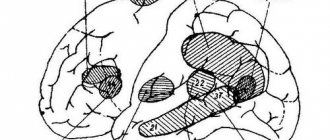Dyslalia and dysarthria are very similar speech development disorders. In both cases, there is a defect in sound pronunciation, often in the same phonemes
It is very rare that an ordinary person, simply by reading about these disorders on the Internet, will correctly distinguish one from the other. Meanwhile, it is important to know how dyslalia differs from dysarthria, since treatment and correction in both cases are individual.
What disorders occur only with dysarthria?
In differential diagnosis, dysarthria differs in leading features. So, this disease is characterized by the following symptoms, which do not appear with dyslalia:
● neurological pathogenesis, expressed in the form of asymmetry of the face, tongue, open mouth with lip paresis, smoothed nasolabial fold
● motor skills disorders - general, fine, speech
● voice defects - constriction, dull sound, slurredness (“mess in the mouth”)
● reduced speech activity
● deviations in diaphragmatic speech breathing, which causes prosody and automation of phonemes
● sleep disorders
● problems with memory capacity, instability of attention, intelligence, history of mental retardation, mental retardation.
● weak activity. People with dysarthria are usually slow and have difficulty switching from one activity to another.
● behavioral disorders - frequent mood swings, psychosis.
Errors in children's speech, oral and written.
Good morning, dear friends and dear parents! The “Vitaminka” program is with you – a program about children’s health.
Today we have a very radio topic - about speech. We will talk about mistakes in children's speech, in oral and written speech. Such serious mistakes that border on diagnosis.
Parents who experience this say it is a very serious problem.
Dysgraphia, dyslexia, dysarthria - this is what we will talk about today, and the main thing is to try to figure out what to do with these problems.
Today our guests are Natalya Shmagina, a neurolinguist at a specialized speech therapy center, and Irina Pravednikova, the head of the Family neuropsychological center. Let's understand the terms: dysgraphia, dyslexia and dysarthria
Irina Pravednikova: Dysgraphia and dyslexia are indeed very serious diagnoses.
As a rule, now the terms “dysgraphia” and “dyslexia” have become commonplace. They evaluate in principle if we consider children. The norm implies certain errors in writing and reading.
That is, dysgraphia is difficulties in writing, dyslexia in reading?
Irina Pravednikova: That’s right, as a rule, they still accompany each other, because oral and written speech are inseparable from each other.
As for dysgraphia, errors can be of different types depending on the underdevelopment of a particular area of the brain.
Our brain takes some time to form and matures heterochronically; each zone of the brain does not develop immediately, but gradually. Some zone at one time, some zone at another time. And accordingly, if some zone is underdeveloped, this can affect writing, reading or speech. Here all the diagnoses are simply piled up: dysgraphia, dyslexia, dyspraxia, and dysarthria.
Dyspraxia – what is it?
Irina Pravednikova: Dyspraxia is also a very serious diagnosis; it is a violation of voluntary movements in the absence of paralysis and paresis.
And this is all interconnected; where there is dyspraxia, dysarthria can begin? Why I ask, because I know that in children, for example, dysarthria is when they speak incorrectly or have porridge in their mouth, or confuse the letters in words.
Example: a child says not “princess”, but “princess”.
Natalya Shmagina: I'm sorry, but you have now made a cocktail of two completely different problems.
When it comes to the fact that a child pronounces phonemes incorrectly, the disorder may relate to a phonemic hearing disorder. That is, that hearing that, unlike ordinary hearing, gives us the opportunity to correctly, precisely correctly, hear the phonemes of our native language. Or with motor problems.
You understand for yourself, when we talk to you, our articulatory apparatus moves. In essence, this is also a motor act, as professionals say. The same movement that you and I do during some other actions.
That's why I asked if dyspraxia and dysgraphia were related.
Natalya Shmagina: this may be a manifestation of both problems. Well, it is impossible to say, for example, that any dysarthric person will have problems with phonemic hearing.
Of course not, but sometimes it comes together.
Natalya Shmagina: rarely, but it happens.
Let's immediately reassure parents whose children have just started speaking and are pronouncing a lot of words incorrectly. This is a norm that should then pass.
Irina Pravednikova: that’s right, if a child at three years old says “hat” instead of “hat,” that’s still normal.
Because he simply does not pronounce “sh”, because something is mixed up in his head.
Irina Pravednikova: but again, I’ll make a reservation, many parents let things go by chance. By the age of 5, the child should definitely have all the sounds. The very last sound according to the norm, as far as speech therapy is concerned, is the sound “r”. By the age of two, a child should have developed phrasal speech, which many parents miss. At 2 years old he doesn’t speak, at 3 years old he doesn’t speak, but that’s okay, tomorrow he will wake up and speak. But in fact, no, you shouldn’t leave it to chance; by the age of 5, a child should speak.
Question from a listener. If the child is 3 years old and instead of the sound “k” he pronounces “t” (instead of “what” - “tata”). Instead of “g” - “d” (“geese” - “dusi”). And instead of “x” - “s” (“I want” - “I want”). Is this still normal at 3 years old?
Natalya Shmagina: at 3 years old this is the physiological norm. There is no need to be scared or afraid, you just need to help the child and pronounce it correctly.
Just fix it?
Natalya Shmagina: not only correct, but also show if possible. Articulating pose, that's easy.
Just make sure your child is looking at you before correcting him. Say: “Please look at me, machine.” Make the pose concentrated, and the child will instantly understand how to place the lips and so on. It's all easy. It’s a different story if you see that the situation is dragging on. Time passes, and the child does not change his pronunciation, then in this case you need to contact a speech therapist. The only thing I’ll correct my colleague a little is that according to the physiological norm, swallowing and not saying the sound “l” until the age of 6 – 6.5 years of the sound “r” is still acceptable. It is better not to delay this process and contact a specialist.
Children swallow, do not finish words, also relates to the same problems, or in general, why does this happen? They are in a hurry, especially when reading a poem. Their words are all going downhill. Why?
Irina Pravednikova: the reasons can be very different. There are children who develop in leaps and bounds. The speech stops, then a huge array is collected, when the array comes to the child.
Natalya Shmagina: especially on the development of phrasal speech.
Irina Pravednikova: if you don’t say at this moment: “Speak more slowly”...
Natalya Shmagina: ...the mouth can’t keep up with the brain.
Is this better than the other way around, in my opinion?
Irina Pravednikova: very often, fast speech is not a fact, but, nevertheless, it is characteristic of retrained left-handers.
Natalia Shmagina: wow, why?
Probably because there is something wedged in the brain?
Irina Pravednikova: in principle, what you said was correct.
Let's talk a little bit about fast speech, too fast speech. If a child is 12 years old and swallows words, is this already a diagnosis or not?
Natalya Shmagina: this is not always a diagnosis. This may be a symptom of the diagnosis. Often this can be a neurotic reaction, that is, signs of neurosis. This is what we are talking about. Or it is a symptom of ADHD (hyperactivity disorder), and it can manifest itself differently in everyone. The children with whom we worked and studied, they may have formed a very good regulatory system. There must be an outlet for this hyperexcitability somewhere. Very often there is an exit to rapid speech.
Irina Pravednikova: or, by the way, when the posterior frontal parts of the premotor region are not formed. To switch from letter to letter, from syllable to syllable, word to word, from sentence to sentence, we need a quick switch.
Where is this area located?
Irina Pravednikova: above the forehead. If in a child this area is a little “wobbly”, malfunctioning, underdeveloped, then it is very difficult for the child to switch quickly, and this is a bad, but compensation - swallowing words.
Let's talk about this. We understand that this is a very serious problem, but I want to know whether this is an independent disorder or whether it always accompanies some serious neurological disease?
Irina Pravednikova: dysarthria is a neurological diagnosis, and in principle it is made by a neurologist. If we talk about a speech therapist-defectologist or even a neuropsychologist, we have the right to only make assumptions and refer to a neurologist to clarify the diagnosis.
And with ADHD (hyperactivity disorder) the picture will be approximately the same. And in itself this is an independent phenomenon that is worth fighting.
Natalya Shmagina: As for dysgraphia and dyslexia, here, in general, it is not necessary to go to a neurologist. If you see errors in your child's writing or reading. I don’t use such terms at all in relation to children. Or I’ll make a reservation: “age-related dysgraphia” and “dyslexia.”
How old is she?
Natalya Shmagina: elementary school for sure. The rules of writing and reading are being mastered, the rules of the Russian language are being mastered. The child's writing and reading skills are automated. Talking about the diagnosis of “dysgraphia” and “dyslexia” is a little incorrect.
Share link:
- Click here to share content on Facebook. (Opens in a new window)
- Click to share on Telegram (Opens in new window)
- Click to share on WhatsApp (Opens in new window)
Pages: 1
What is the difference between dysarthria and dyslalia?
According to its etiology, dysarthria is not an independent disorder. Its appearance is associated with congenital or acquired organic lesions of the central nervous system. It manifests itself in injuries, cerebral palsy, neuroinfections, problems with cerebral circulation, tumors, asphyxia, Rh conflict with the mother, and so on. Dyslalia is not associated with organic matter. It occurs:
• in somatically weakened children
• with pedagogical neglect
• with abnormal development of the articulatory apparatus.
In the case of dysarthria, the pronunciation and prosodic aspects of the sound flow suffer, omissions and phonemic substitutions are observed. With dyslalia, problems are expressed only in sound pronunciation.
Diagnostics
To make a diagnosis, additional examinations may be required:
- MRI of the brain.
- X-ray of the head. Electroencephalography.
- Neurosonography
Diagnostic tests allow us to understand how much the brain is affected. This is the only way to determine the course of treatment and its main stages. Parents will also have to visit an otolaryngologist and speech therapist. Based on a set of studies, a diagnosis is established.
Remember that alalia does not contribute to a decrease in hearing and intelligence. However, visiting an otolaryngologist, performing an otoscopy and audiometry will help rule out other possible disorders that may also affect speech impairment.
Specialists additionally carry out differential diagnostics, which helps to evaluate a number of significant criteria and accurately determine the form of alalia. The following skills are assessed:
- speech understanding and listening comprehension;
- ability to repeat sounds and individual words;
- the child’s reactions in the form of gestures and facial expressions to spoken speech;
- development of other communication skills;
- dynamics of speech development over time.
It is important to undergo a full examination in order to more accurately select a correction program for the child and treatment format.
How to correctly diagnose a speech disorder
The most important advice in a situation of problematic speech communication is not to listen to girlfriends, neighbors, acquaintances, that is, “it happened to me.” Perhaps it was, but in each case the violations occur in an individual form. Moreover, avoid visiting grandmothers who “pour out their voices.” Usually there is unsanitary conditions and a minimum of medical skills. If someone experienced improvements after such meetings, this is a coincidence. No slander, killed roosters, etc., are in any way connected with speech, much less, they do not recognize the differences between dyslalia and dysarthria.
To specify the diagnosis, you need to contact a qualified speech therapist. There are such specialists in every city. After a complete examination, he may also send you to a neurologist. A comprehensive examination is a necessity, not a waste of time. It is sometimes difficult to get a routine diagnosis without a referral, especially in small towns where there is only one doctor for the entire area. Therefore, take the opportunity to know exactly what your child is suffering from and how to treat it.
Symptoms
A child with a speech development problem is immediately visible. Alalia can be determined if the child does not react when addressed by name, does not utter words and individual phrases, and is not able to fulfill basic requests. In this case, the specialist draws up a comprehensive treatment plan, during which it is extremely important that the parents make a lot of their own efforts. Psychologists and neurologists, as well as a pediatrician, will help determine the symptoms of disorders.
A psychologist can identify signs of the disease such as:
- memory problems;
- inability to maintain attention;
- hyperactivity (but the exact opposite phenomenon may also occur - low mobility);
- high rate of fatigue;
- aggression without reason;
- nervous excitability.
It is quite difficult for a child who does not understand what is being said to him to adapt to society. This causes a number of related problems (with health, adequate reactions, behavior).





